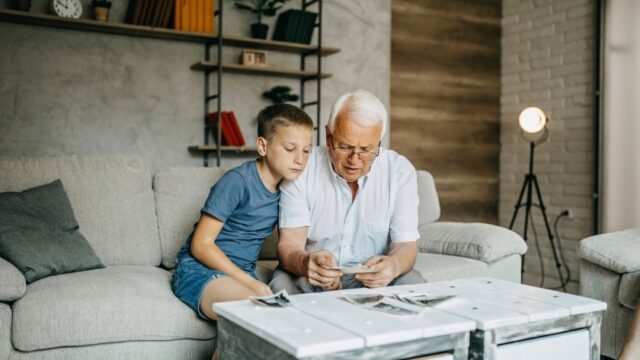Tip Sheet
How to Leverage the National Youth Risk Behavior Survey to Learn More about Children in Kinship Families
Download This Resource
Understanding the well-being of children living in all family arrangements, including those in kinship/grandfamilies, is important for the program and planning efforts of agencies that provide services to children and caregivers. Building population assessment measures can be costly for programs with limited funds. Utilizing opportunities to draw on existing data can be a cost-effective way to support program and planning efforts.
The terms “grandfamilies” and “kinship families,” used throughout this document, refer to all families in which grandparents, other relatives, or close family friends are raising children whose parents are unable to do so. The terms can be used interchangeably to refer to these families.
The Centers for Disease Control and Prevention (CDC) partners with states, territories, and several tribes to conduct a Youth Risk Behavior Survey (YRBS), which collects youth risk behavior data for all children in grades 8, 10, and 12 enrolled in public schools across the United States. The survey is given to students every other year during the Spring semester. Child well-being measures that are assessed through this tool include physical, mental, and sexual health indicators. Specific youth risk behaviors measured include sexual risk-taking behavior (level of sexual activity, use of contraceptives that prevent pregnancy and exposure to sexually transmitted infections), substance use, suicidality, bullying, physical activity, and nutrition.
Washington State is currently the only state in the U.S. that is using the YRBS to assess and track the well-being of children in kinship families. Other states, tribes, and territories can learn from Washington State’s example and use the YRBS survey to collect and analyze data about children who live in kinship/grandfamilies in their communities.
Why add kinship-related questions to the YRBS?
By adding kinship-related questions to your YRBS, you will be able to learn more about children in kinship/grandfamilies and their strengths and needs so that you can better tailor your services to them. Washington has used the data to create and post easily digestible fact sheets on its Department of Social and Health Services (DSHS) Kinship Publications page, as linked below.
- Washington State Youth in Kinship Care & Foster Care (which focuses on demographics)
- Education Outcomes Among Youth in Kinship Care & Foster Care in Washington State
- Mental Health Outcomes Among Youth in Kinship Care & Foster Care in Washington State
- Substance Use and Abuse Among Youth in Kinship Care & Foster Care in Washington State
More information on how Washington State utilizes this data across the state can be found here.
Where can I find my jurisdiction’s YRBS data?
The CDC has a page on their site to provide data collected through YRBS, including national, state, and local district results. This is a centralized place to find data from multiple sites, though the data here may be older than what is available from your local site. It is also important to know that the federally accessible data does not specifically distinguish youth in kinship/grandfamilies from other youth.
The easiest way to find your state data is to search “YRBS [State Name]” in your favorite search engine. States might give this survey a different name. For example, in Washington State it is called the Healthy Youth Survey. This Survey is sponsored by multiple agencies, including the Office of Superintendent of Public Instruction, Washinton State Department of Health, Washington State’s Health Care Authority Division of Behavioral Health and Recovery, and the Liquor and Cannabis Board.
Where can I find the current question list for our local YRBS?
Standard questionnaires for the high school and middle school YRBS can be found on the CDC website.
Since states, tribes, and territories can include or remove specific questions, each jurisdiction’s questionnaires could be different compared to those listed on the CDC website and should be found on the same website as the YRBS data for your area. In
Washington State, the current and past questionnaires can be found under the resources section of the Healthy Youth Survey website.
How can a question be added to the YRBS in our state, tribe, or territory?
Each jurisdiction has a process, including deadlines, to add a new question or change a current question in their YRBS. All suggestions are then compiled and reviewed by an elected board and voted on utilizing a ballot process. Questions are reviewed for readability and clarity, as well as grade reading level. The language of a question may be changed based on the results of the review.
If you would like to add a kinship question or propose a question change for an existing question that would allow you to better understand its impact on kinship youth, contact one of your state or local YRBS officials through one of the sponsoring agencies. These agencies usually include your state department of health and department of education.
What questions can we add to the YRBS to learn more about children in kinship care?
By adding questions concerning the people with whom the child lives, data can be analyzed for youth based on their caregiving arrangement. Below are three sample questions designed and utilized by Washington State in their Healthy Youth Survey to identify and learn more about the well-being and behaviors of youth who are living in kinship/grandfamilies and foster families.
- Who did you live with most of the time in the last 30 days?
- Parent(s), step-parent(s), or legal guardian
- Relatives like a grandparent, an aunt, or an older brother – but NOT your parents
- Foster care parent(s)
- Adults who are not your parents, relatives, or foster parents
- Friends who are not your parents, relatives, or foster parents
- On you own
- Other
- Where did you live most of the time in the last 30 days?
- In a house or apartment that my family rents or owns
- In a house or apartment that a relative rents or owns
- In a house or apartment who someone who is not a relative
- In a shelter
- In a car or RV, park, or campground
- In a motel/hotel
- On the street
- Moved from place to place
- Other
- Are your current arrangements the result of losing your home because your family cannot afford housing?
- No
- Yes
- Not Sure

